VINCE SCAPPATURA AND RICHARD TANTER
AUGUST 26 2024
I. INTRODUCTION
Vince Scappatura and Richard Tanter use open-source information to identify US B-52 bombers that are nuclear weapons capable and may visit or be stationed at foreign airfields versus B-52s that are solely able to be armed with conventional, non-nuclear weapons. Where governments, as in the case of Australia, refuse to state whether visiting nuclear-capable B-52 bombers may carry nuclear weapons, citing the US neither-confirm-nor-deny policy as justification, it amounts to a state of wilful ignorance on the strategic implications of supporting such operations.
The full version of the Special Report is available here (11.3MB PDF) and at the B-52 Stratofortress Bombers Project here and press information kit here.
Vince Scappatura is Sessional Academic in the Macquarie School of Social Sciences at Macquarie University, and author of The US Lobby and Australian Defence Policy, Melbourne: Monash University Publishing, 2019.
Richard Tanter is Senior Research Associate at the Nautilus Institute, and co-author, with Desmond Ball, of Japan’s Signals Intelligence (SIGINT) Ground Stations: A Visual Guide, Nautilus Institute Special Report, 6 August 2015. He recently published Does Pine Gap place Australia at risk of complicity in genocide in Gaza? A complaint concerning the Australian Signals Directorate to the Inspector General of Security and Intelligence, 27 March 2024
The views expressed in this report do not necessarily reflect the official policy or position of the Nautilus Institute. Readers should note that Nautilus seeks a diversity of views and opinions on significant topics in order to identify common ground.
Acknowledgements: Our thanks to Peter Hayes, executive director of the Nautilus Institute for his support for this project and for a close reading of earlier drafts; to Pavel Podvig of UNIDIR for advice and help in gaining a better understanding of arms control issues; and to Hans Kristensen of the Federation of American Scientists for his original insight on the core issue of this study. Jon Lake, co-editor of Boeing B-52H Stratofortress Bookazine 2022, was generous and collaborative with his expert assistance. Duncan Campbell and Jo Vallentine were helpful in tracking down small mysteries. David Lee and Philip Dorling guided us to cabinet archival sources. We also benefited greatly from the remarkable work of the late Dr Joe Baugher on USAF aircraft historical data. We thank the staff of the University of Melbourne Library for their help in providing timely access to materials for this project.
We are grateful to Dave Parer for his kind permission to use his photograph of B-52H 61-0019 over the Australian city of Townsville in August 2015 on the cover of this study.
Many of the photographs reproduced in this work appeared originally on United States Department of Defense (DoD) and armed services websites. The appearance of DoD visual information does not imply or constitute DoD endorsement.
We are grateful for the work and generosity of professional and specialist photographers on whose excellent work we have relied, and for their permission to reproduce their work: Ian Abbott, Steve Barnes, Kevin Bell, Jack Cook, Kyle Cortis, Charles Dover, Jason Grant, Lieuwe Hofstra, Andrew Lawrence, Eric Page Lu, Jay Dee Kay, Owen O’Rourke, Dave Parer, Mark Piacentini, Eric Salard, Andrei Schmatko, Reed Skyllingstad, Bruce Smith, Adrian Stürmer, Michiel Van Herten, Matt Varley, Markus Willmann, Chris Wood, Hao Wu, MRC Aviation, N94504, RedRipper24.
Cover image: Dave Parer, ‘61-0019 – Townsville,’, Jet Photos.net, photo date 15 August 2015, uploaded 6 September 2015, at https://www.jetphotos.com/photo/8089329 used with permission. B-52H Stratofortress 61-0019 was in 2015, and remains in 2024, a nuclear-capable bomber.
II. NAPSNET SPECIAL REPORT BY VINCE SCAPPATURA AND RICHARD TANTER
NUCLEAR-CAPABLE B-52H STRATOFORTRESS BOMBERS: A VISUAL GUIDE TO IDENTIFICATION
AUGUST 26 2024
Summary
This report provides robust, authoritative and transparent information for use by governments and their publics in countries that host the B-52H Stratofortress bomber, as to which of the 76 B-52H aircraft in the current (as of mid-2024) US Air Force active fleet are capable of delivering nuclear weapons, and which can deliver only conventional, non-nuclear weapons.
For the governments and citizens of B-52 host countries, obtaining authoritative and accessible information concerning the introduction of both nuclear-capable delivery platforms and nuclear weapons themselves is essential for responsible decision-making and democratic accountability. To date, there is no systematic, robust and transparent information on either of these matters in the public domain.
The presence of nuclear-capable delivery platforms is a necessary, though obviously not sufficient, requirement for the introduction of long-range strategic nuclear weapons into any given country. If there are no declared policy or legal impediments to introducing nuclear weapons into a given country, hosting nuclear-capable delivery platforms from an allied state amounts to a near proxy for nuclear weapons deployment, and creates the possibility of participation in nuclear-armed operations.
B-52 and B-2 bombers are the only elements of the US nuclear triad regularly and frequently deployed for shorter or longer periods to the territories of allied host countries outside of the United States. While all B-2 Spirit bombers are capable of being armed with both nuclear and conventional weapons, the US Air Force B-52H active fleet consists of a mix of 46 dual-capable and 30 conventional-only aircraft, rendering the strategic implications of their deployment more ambiguous.
Due to the long-standing US policy of neither confirming nor denying the presence of nuclear weapons on board US ships, submarines or aircraft, US-allied governments and their publics are denied the knowledge of whether they are hosting B-52 bombers strictly limited to conventional strategic operations, or hosting dual-capable aircraft that could potentially implicate their country in US nuclear missions.
The challenges of democratic transparency and accountability faced by countries hosting US B-52 strategic bombers is illustrated by contemporary developments in the case of Australia, where plans are underway for the US Air Force to forward-base up to six B-52H aircraft at Tindal Air Force Base in the far north of the country.
Although B-52 bombers, and other US aircraft, already regularly visit Australia, the planned deployment at Tindal AFB will be accompanied by an unprecedented infrastructure expansion project signifying a shift from existing air cooperation arrangements centred on joint training exercises and enhancing interoperability to a focus on strategic operations and potential air combat missions launched from Australian territory, including conceivably nuclear missions.
Although the Australian government declares a ‘fundamental right to know what activities foreign governments conduct in, through or from Australian territory or national assets’, this assertion of national sovereignty is difficult to reconcile with the apparent willed ignorance that flows from Australia’s ‘understanding of and respect for’ the US doctrine of neither confirming nor denying the presence of nuclear weapons on board US aircraft, including whether the upcoming deployment of B-52 bombers to Tindal AFB will be nuclear-capable or conventional-only.
The Australian case of willed ignorance points to the fact that this study could have been, and should have been, carried out by government agencies of any of the host countries that permit B-52 deployments. Like the Australian government, these governments deny themselves and their citizenry even a minimum degree of transparency regarding the armament capability of US Air Force B-52 bombers that enter into and operate from their national territories, leaving them to rely on what is, finally, an implausible deniability.
TABLE OF CONTENTS
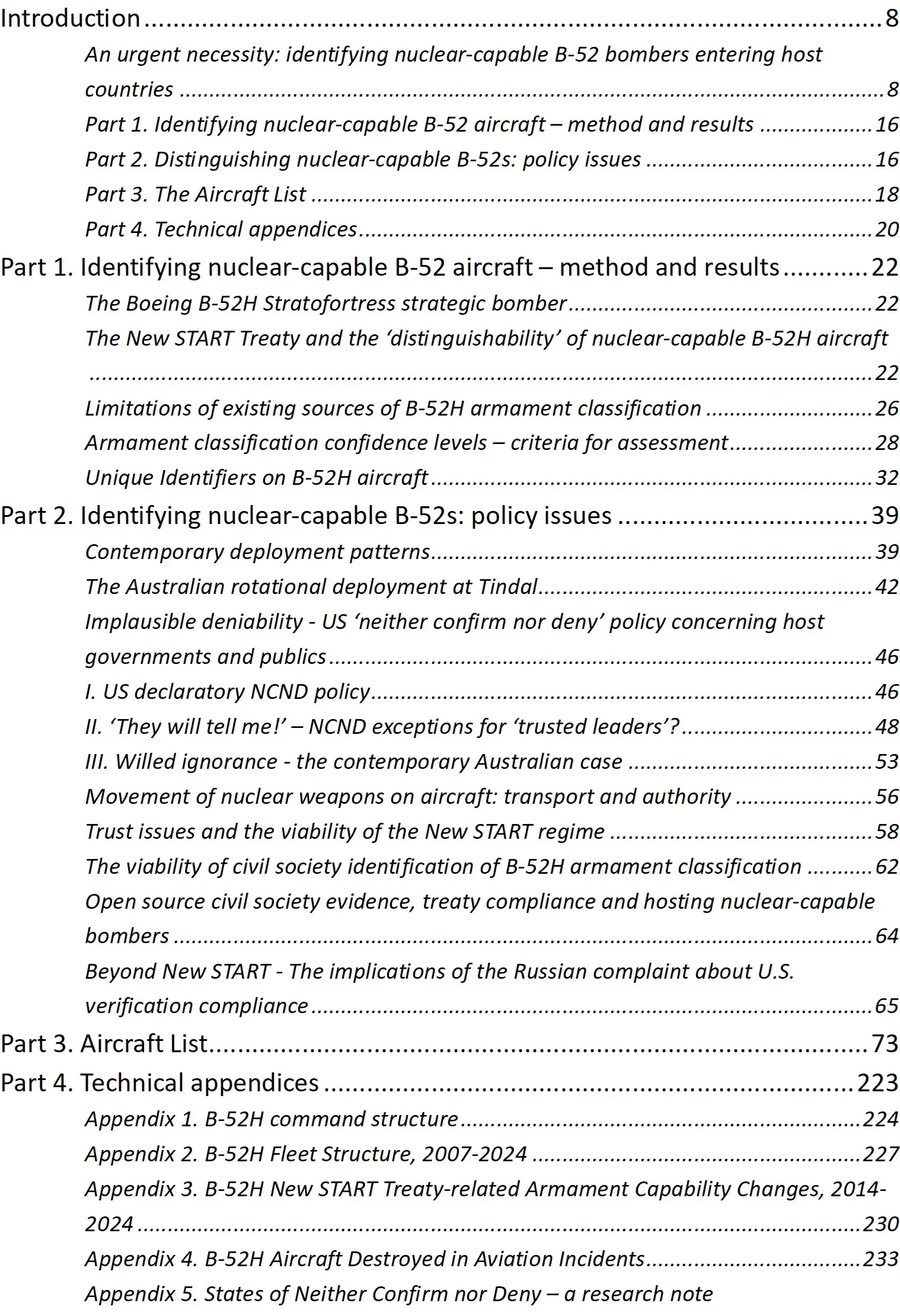
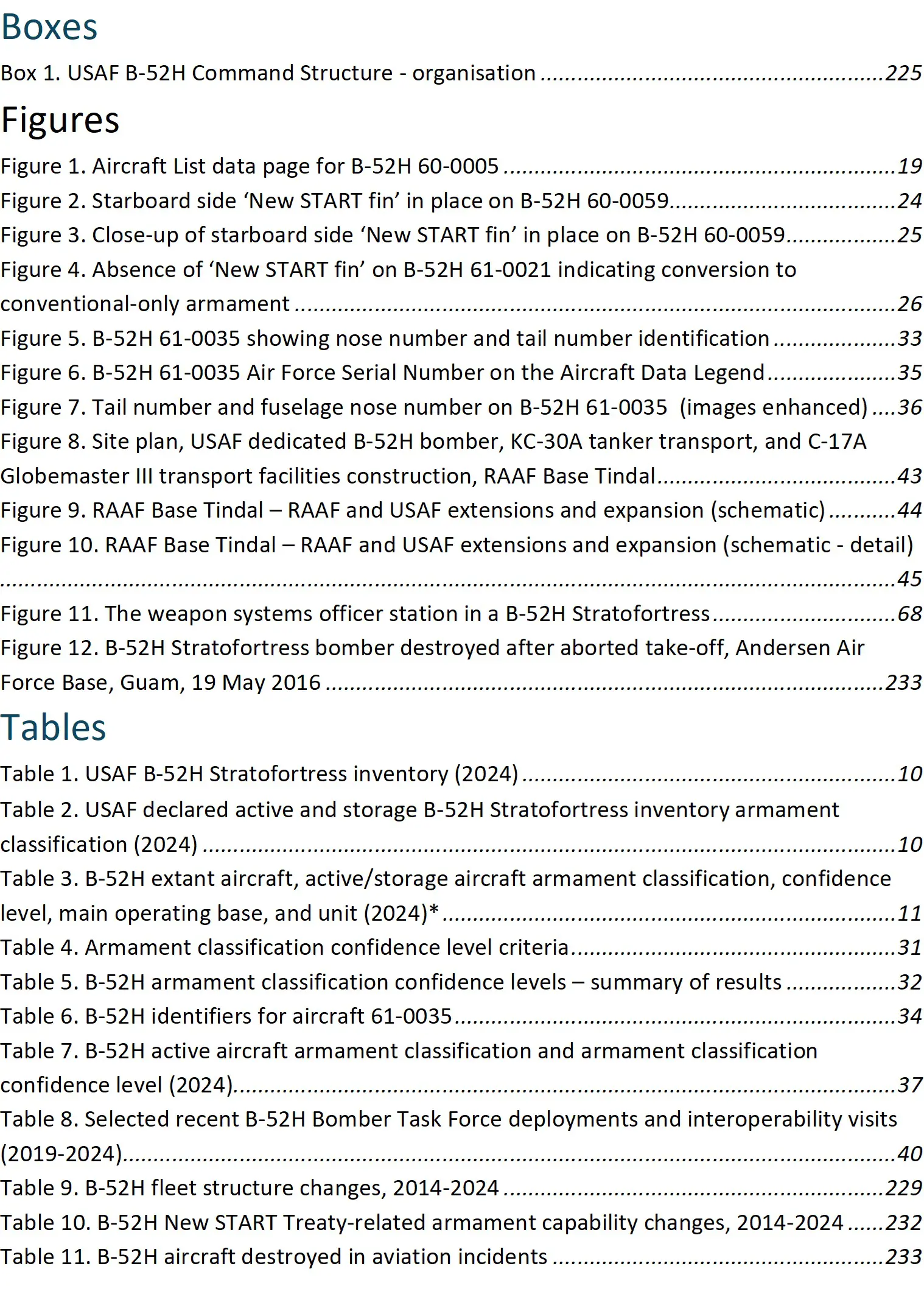

INTRODUCTION
An urgent necessity: identifying nuclear-capable B-52 bombers entering host countries
The primary aim of this Nautilus Special Report is to provide robust, authoritative and transparent information for use by governments, and their publics, that host the Boeing B-52H Stratofortress heavy bomber, as to which in the current (as of mid-2024) US Air Force (USAF) inventory are capable of delivering nuclear weapons, and which can deliver only conventional, non-nuclear weapons.[1]
To date, there is no systematic, robust and transparent information on this matter in the public domain.
This study could have been, and should have been, carried out by government agencies of any of the countries that permit deployment of B-52H aircraft.
Transparency and accountability should be at the foundation of government policies of reliance on nuclear defence given the immense destructive power of nuclear weapons and the risks inherent in managing both the strategic and human security and safety consequences of such policies.
When nuclear weapons from a foreign state are introduced into one’s national territory, it is a matter of profound strategic significance for the government and the people of that country, for that country’s neighbours, and for possible adversary states. Once made, the strategic consequences of nuclear weapons hosting remain significant, even if abandoned over time.
Even hosting non-nuclear armed but nuclear-capable weapons platforms – the means of delivery of a nuclear weapon to its intended target – entails strategically significant consequences. If there are no declared policy or legal impediments to introducing nuclear weapons into a given country, hosting nuclear-capable delivery platforms from an allied state amounts to a near proxy for nuclear weapons deployment, and creates the possibility of participation in nuclear-armed operations.
Together with intercontinental ballistic missiles and submarine launched ballistic missiles, USAF B-52 and B-2 strategic bombers are a key element in the US strategic nuclear force, which overall is capable of delivering over 3,500 nuclear strategic warheads.[2] In this nuclear triad, B-52 and B-2 bombers are the only elements regularly and frequently deployed for shorter or longer periods to allied host countries outside the United States. At present these countries include Australia, Spain, the United Arab Emirates, and the United Kingdom, in addition to the disputed territories of Diego Garcia and Guahan (Guam).
Of the two nuclear-capable strategic bomber fleets operated by the USAF, only the B-52H consists of a mix of dual-capable and conventional-only aircraft.[3] Since March 2017, the USAF inventory of B-52H Stratofortress bombers has consisted of 46 dual-capable aircraft able to deliver both nuclear weapons and non-nuclear weapons and some 30 denuclearised aircraft converted to deliver only conventional, non-nuclear weapons.[4]
For the governments and citizens of B-52 host countries, obtaining authoritative and accessible information concerning the introduction of both nuclear-capable delivery platforms and nuclear weapons themselves is essential for responsible decision-making and democratic accountability.
The question of distinguishing between nuclear-capable and conventional-only B-52H bombers only became a relevant issue over the past decade. Prior to 2015, all B-52H aircraft in the USAF inventory were nuclear-capable. Thereafter, the Obama administration initiated a process to convert a portion of the B-52H force so that they were only capable of carrying conventional weapons. This program was undertaken in anticipation of treaty limits between the United States and the Russian Federation coming into effect on 5 February 2018 on the number of offensive strategic arms in both countries (New START).
The USAF inventory of B-52H aircraft is currently made up of 76 aircraft in the active fleet, an additional five non-flyable inactive aircraft used for ground instruction and training (GITA) or research and testing, and eleven aircraft in long-term storage, one of which has been dismantled (Table 1). According to US declaratory policy, 46 of the 76 aircraft in the active fleet are nuclear-capable, leaving 30 as conventional-only. Another ten of the 11 aircraft in storage are declared to have been converted to conventional-only armament, and can be returned to the active fleet after a period of restoration (Table 2).[5]
Listing all extant B-52H aircraft in the USAF inventory by Air Force Serial Number, Table 3 summarises the findings of this Special Report for each aircraft concerning the status of the aircraft (active, storage-restorable, storage-dismantled, inactive/GITA), and its armament classification, the confidence level of that armament classification, its main operating base, and unit designation.
Table 1. USAF B-52H Stratofortress inventory (2024)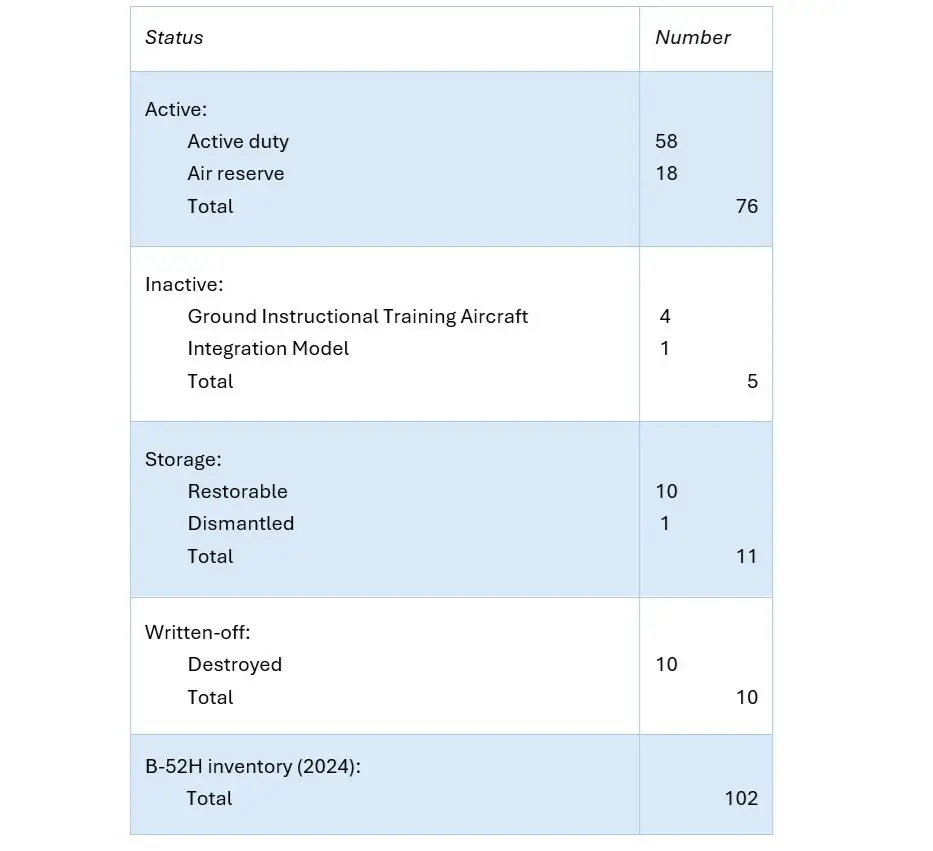
Table 2. USAF declared active and storage B-52H Stratofortress inventory armament classification (2024)

Table 3. B-52H extant aircraft, active/storage aircraft armament classification, confidence level, main operating base, and unit (2024)
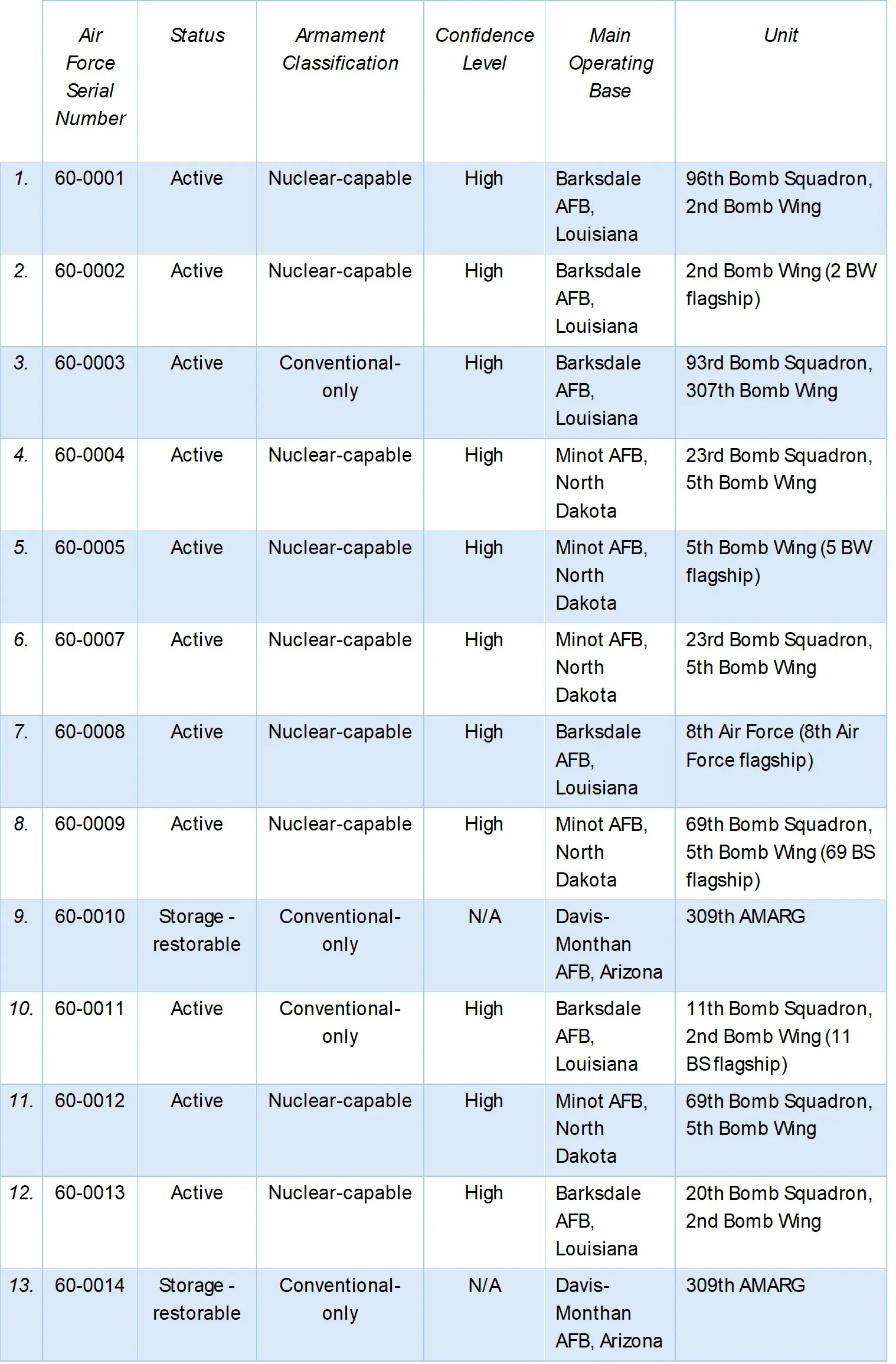
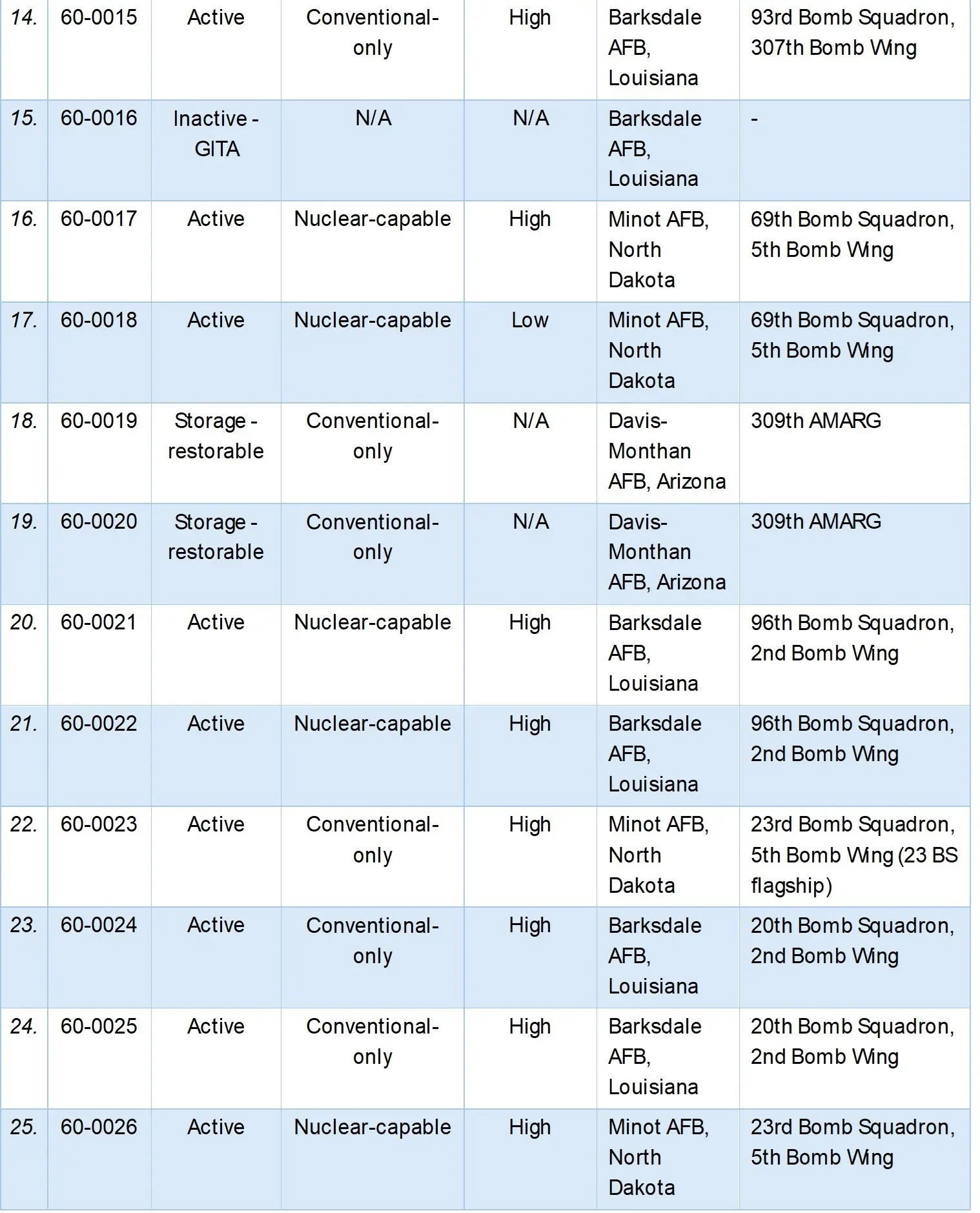
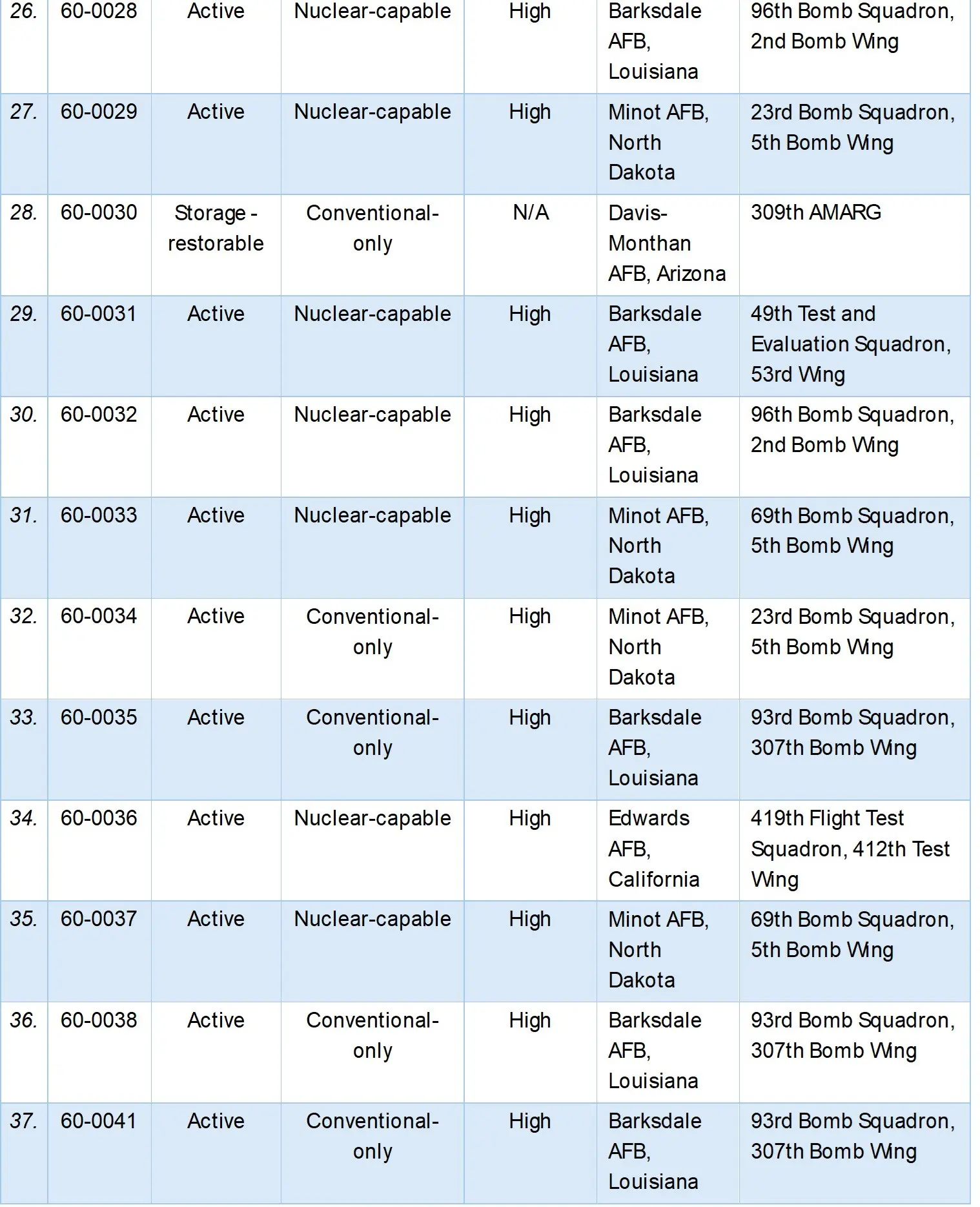
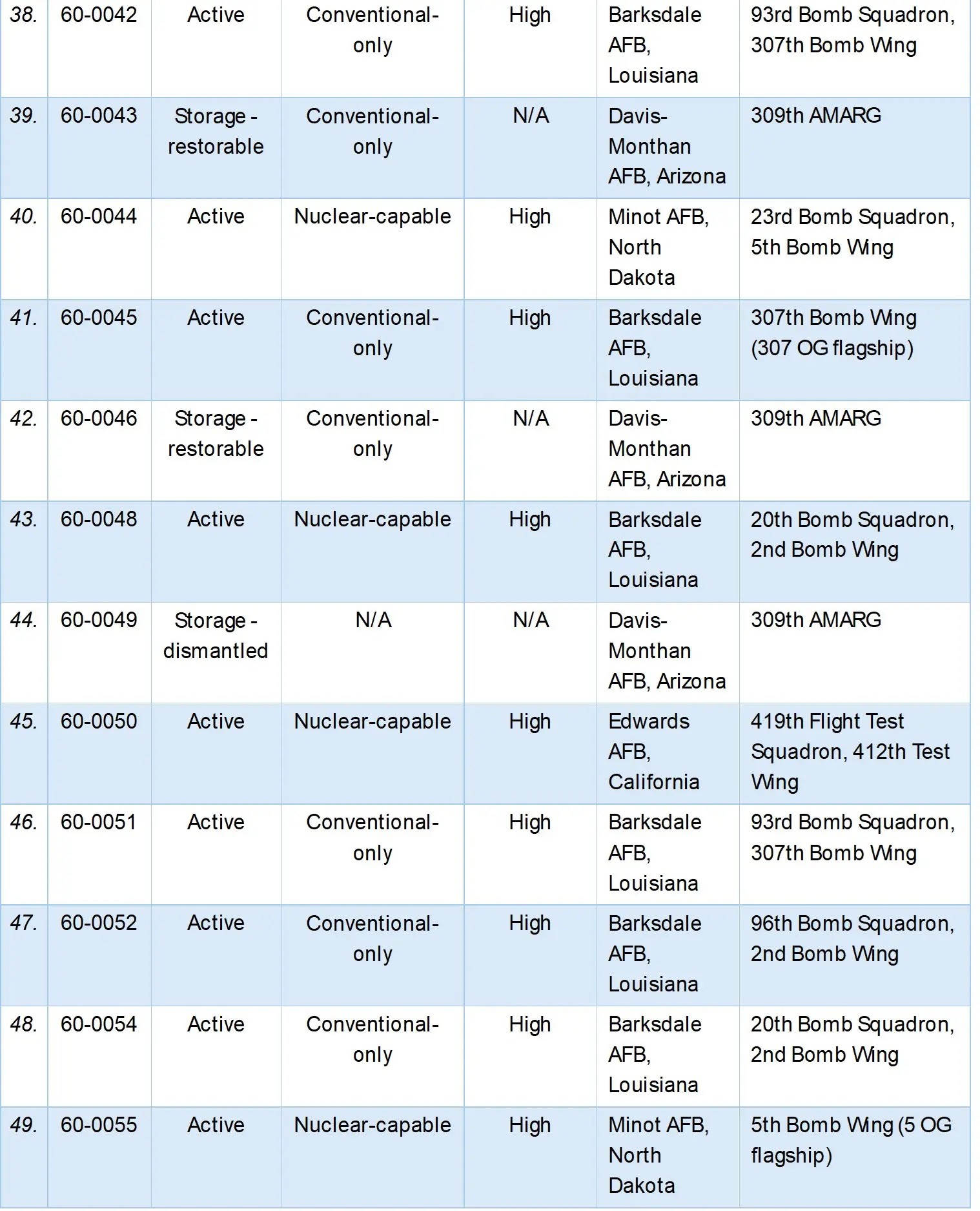
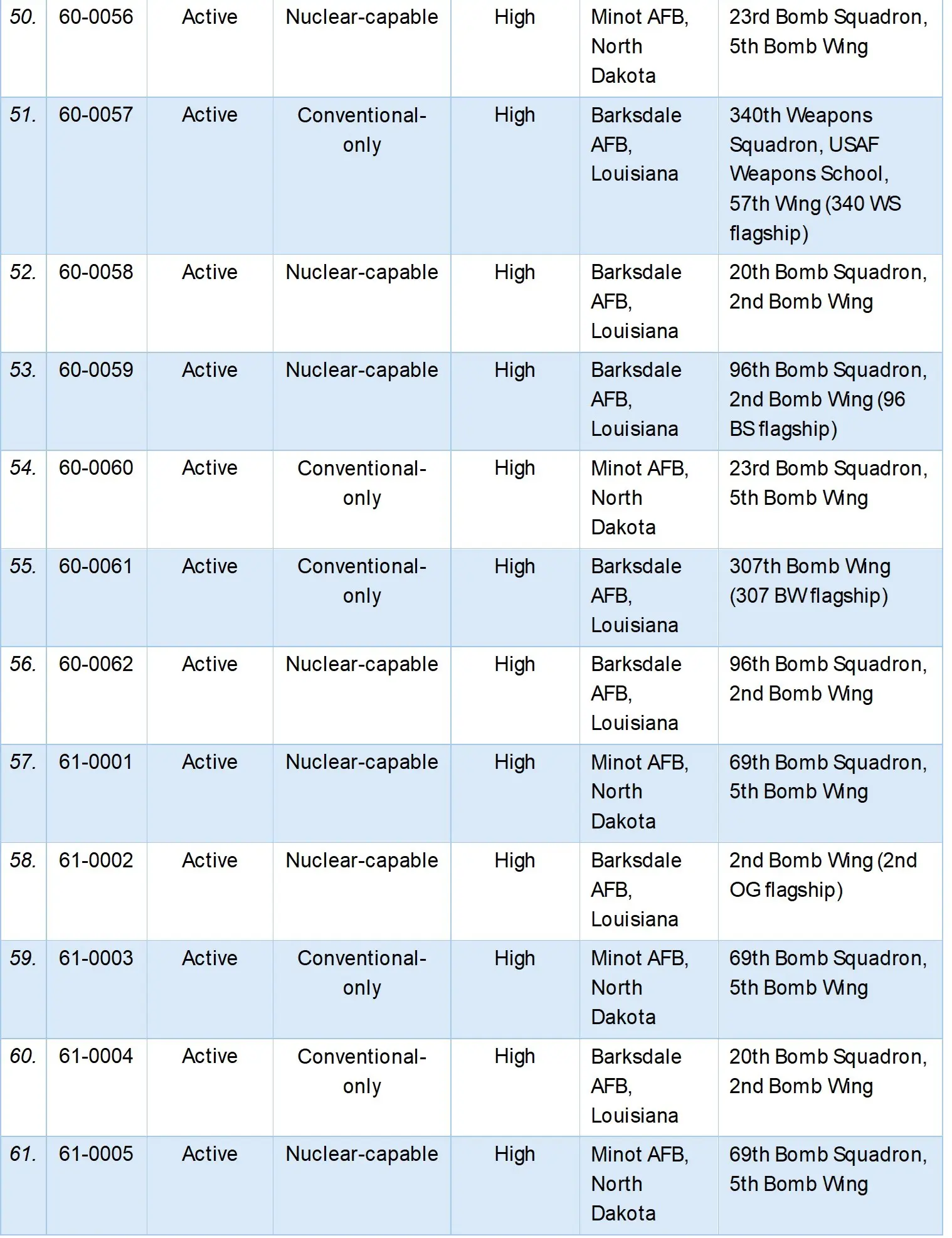
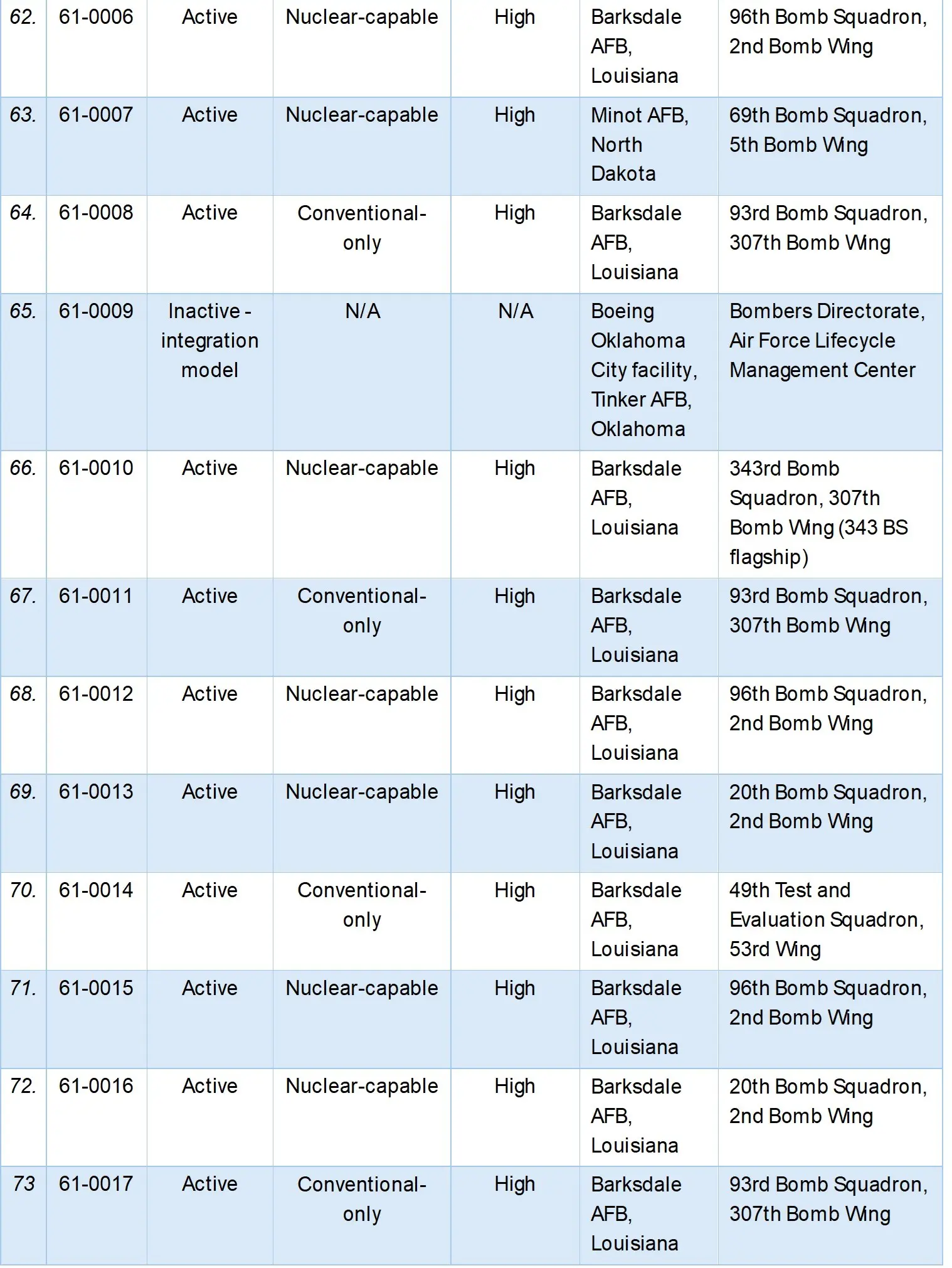
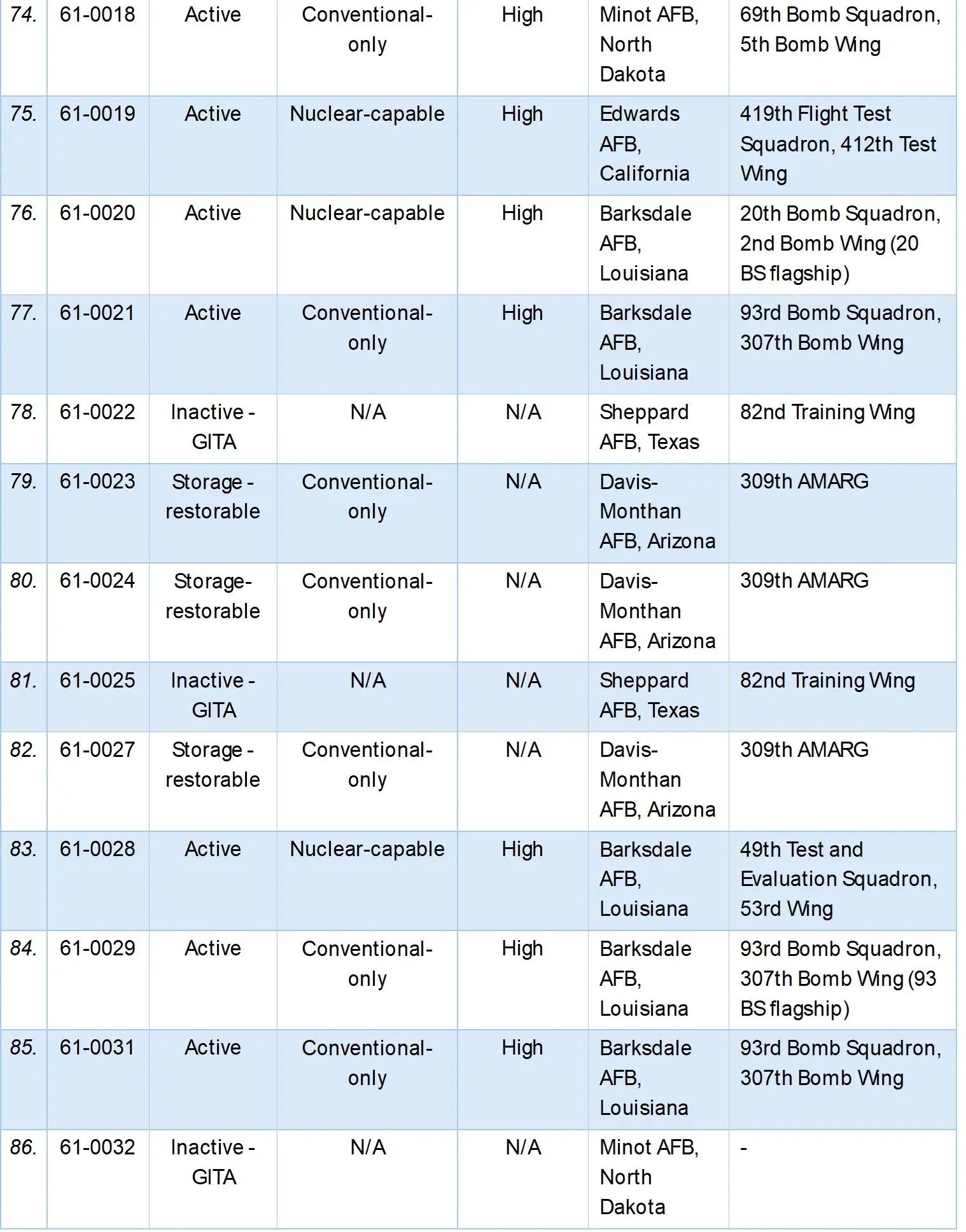
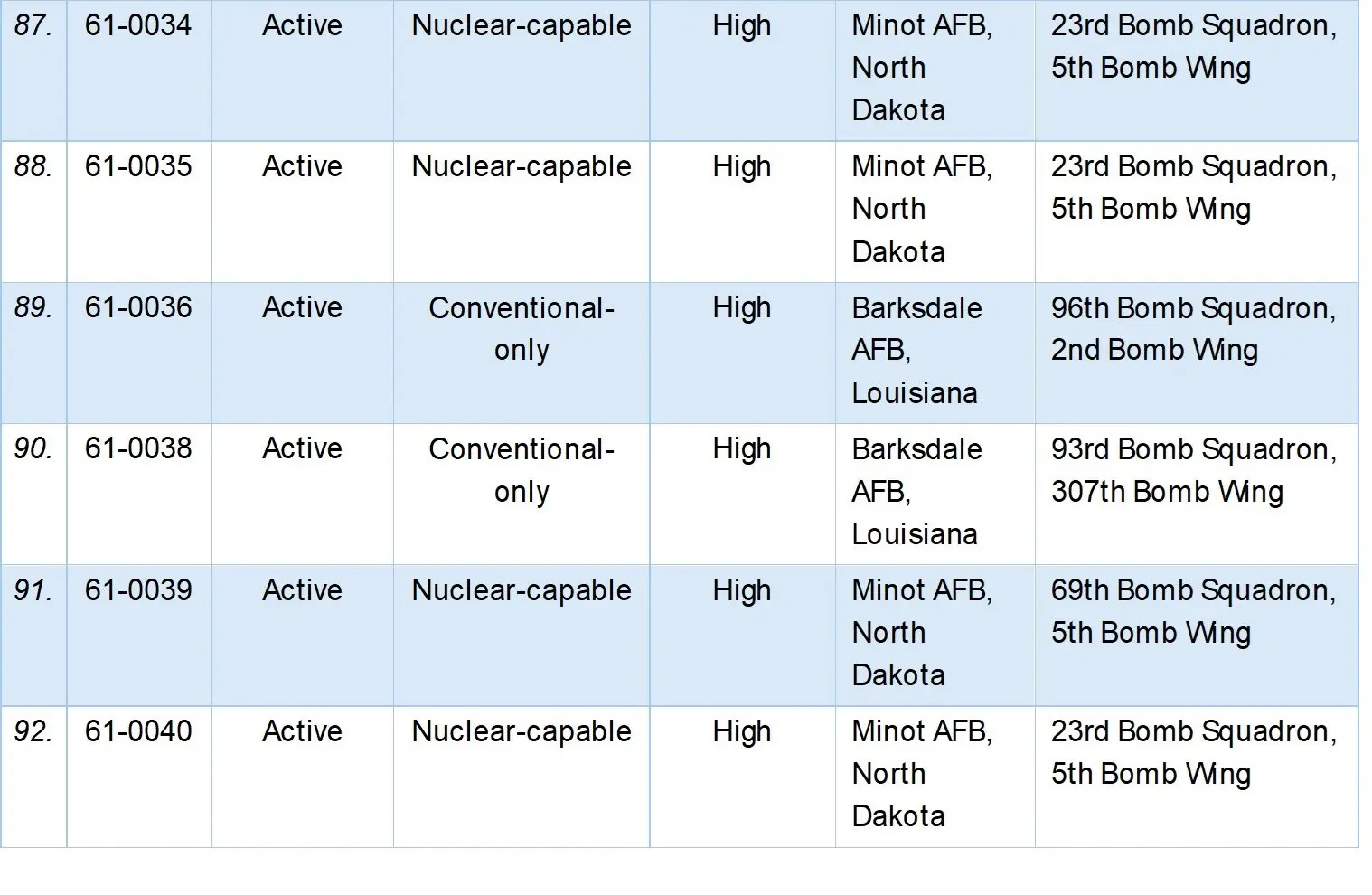 Notes to Table 3: a. Confidence levels apply only to the armament classification assigned to active aircraft. b. AMARG – Aerospace Maintenance and Regeneration Group; GITA – ground instructional training aircraft; OG – Operating Group. c. Although best efforts have been made to ensure the accuracy of unit designations as of mid-2024, difficulties arising from changes in some unit designations over time may have resulted in some errors.
Notes to Table 3: a. Confidence levels apply only to the armament classification assigned to active aircraft. b. AMARG – Aerospace Maintenance and Regeneration Group; GITA – ground instructional training aircraft; OG – Operating Group. c. Although best efforts have been made to ensure the accuracy of unit designations as of mid-2024, difficulties arising from changes in some unit designations over time may have resulted in some errors.
Part 1. Identifying nuclear-capable B-52 aircraft – method and results
The work in this Special Report is set out in four separate parts.
Part 1 focusses on the armament capability of the active B-52H fleet and the methods involved in distinguishing nuclear-capable aircraft from those that are conventionally-armed only, the procedures and evidence used in this study to classify the armament status of active fleet aircraft, and the summary results of those classification procedures.
The key evidence utilised in this study for distinguishing nuclear-capable and conventional-only B-52H aircraft lies in treaty-mandated external observable and verifiable features the United States implemented when converting a certain number of previously nuclear-capable B-52H aircraft to conventional-only status, rendering them incapable of using nuclear weapons.
After discussion of the New START treaty, its verification requirements, and its protocol on inspection, Part 1 continues with a discussion of the limitations of existing sources of data on armaments classification of B-52 aircraft, before moving to an outline of the methods used in this study.
Since the goal of this Special Report is to provide a reliable and transparent source for both host governments and their publics to distinguish between nuclear-capable and conventional-only B-52s, Part 1 provides an extensive outline of the methods used in the report, the confidence criteria developed to assess evidence, and data on the confidence levels attained (Tables 4 and 5). For all but one of the 76 active aircraft, the confidence criteria assigned in the Aircraft List in Part 3 are rated as ‘High’.
This section continues with a discussion of the system of unique identifiers for individual aircraft employed by the US Air Force and applied under the New START treaty.
The primary results of this study are presented in summary form in Table 7. The detailed evidence for each individual aircraft is presented in Part 3.
Starboard side ‘New START fin’ in place on B-52H 60-0059
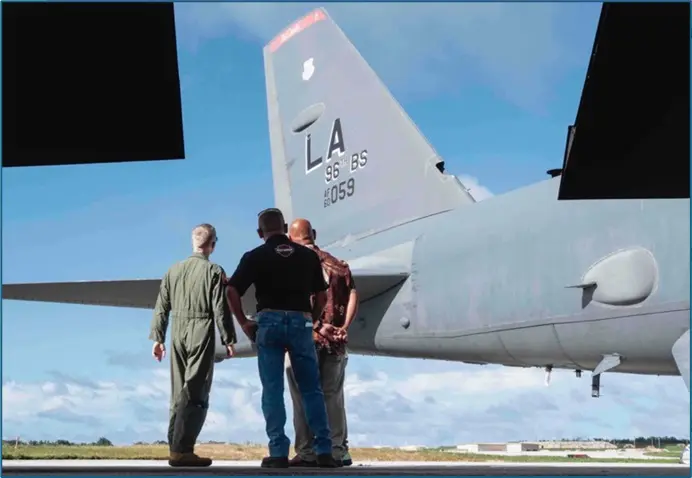 Source: Lauren Clevenger, ‘Guam Mayors visit Andersen AFB [Image 10 of 11]’, DVIDS, photo ID: 8114536, VIRIN: 231103-F-NI202-1227, photo date 11 November 2023, uploaded 11 November 2023, [accessed 17 February 2023], at https://www.dvidshub.net/image/8114536/guam-mayors-visit-andersen-afb
Source: Lauren Clevenger, ‘Guam Mayors visit Andersen AFB [Image 10 of 11]’, DVIDS, photo ID: 8114536, VIRIN: 231103-F-NI202-1227, photo date 11 November 2023, uploaded 11 November 2023, [accessed 17 February 2023], at https://www.dvidshub.net/image/8114536/guam-mayors-visit-andersen-afb
Part 2. Distinguishing nuclear-capable B-52s: policy issues
There are a number of key policy questions to which the issue of distinguishing nuclear-capable from conventional-only B-52H aircraft is salient. Part 2 begins with a review of contemporary basing and deployment patterns of B-52H aircraft, both in the United States and abroad, summarising an intensifying pattern of recent selected examples of B-52H deployments of differing frequency, duration and type to these countries and territories (Table 8). This review also includes an important recent announcement of the development of dedicated USAF physical infrastructure at a major air base in northern Australia in preparation for hosting up to six B52H aircraft on ‘rotational deployment’ (Figures 8, 9 and 10).
RAAF Base Tindal – RAAF and USAF extensions and expansion (schematic)
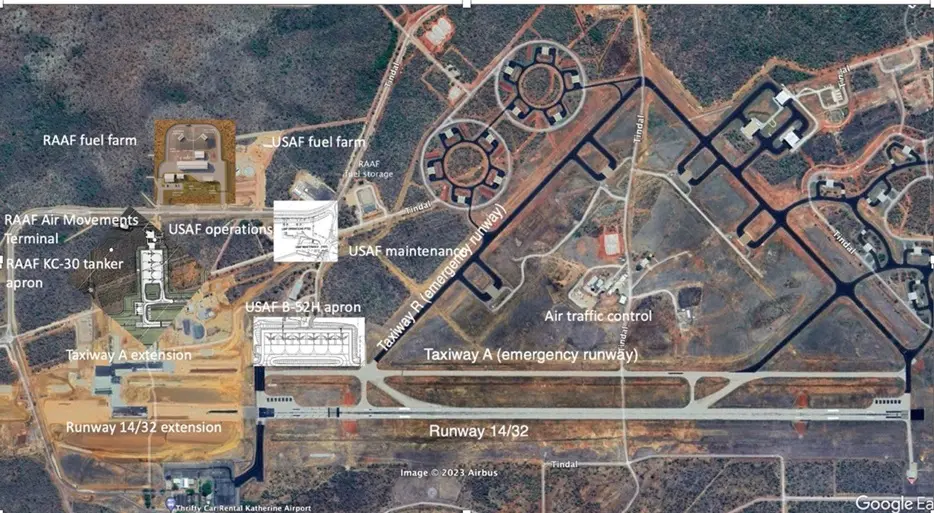
Sources: Google Earth, 5 November 2022; Industry Capability Network, EST00346 TDL Redev / EST00347 KC-30A Facilities, Work Package: Invitation to Register (ITR) Brief, Project Registration Form, EST00346 RAAF Base Tindal Redevelopment Stage 6 and EST00347, US Force Posture Initiatives (USFPI) RAAF Base Tindal Airfield, Works and Associated Infrastructure, [accessed 14 May 2023], at https://gateway.icn.org.au/project/4161/est00346-tdl-redev-est00347-kc-30a-facilities.
A core concern of this part of the Special Report is the United States government doctrine of neither confirming nor denying the presence or absence of nuclear weapons on board US ships, submarines or aircraft. Unchanged for almost seventy years, the neither-confirm-nor-deny doctrine has been applied consistently and worldwide, with a very small number of exceptions.
Policy transparency required for democratic accountability is fundamentally denied by the application of this doctrine of neither confirming nor denying the presence of nuclear weapons on USAF aircraft to the publics, and, also it would appear, to the governments of countries such as Australia, Spain, the United Arab Emirates, and the United Kingdom that frequently host the deployment of USAF B-52H aircraft, as well the United States itself and the United Kingdom in their disputed external territories of Guahan and Diego Garcia.
The application of neither-confirm-nor-deny policy is discussed in three sections, beginning with a general discussion of contemporary USAF policy and the security rationales proffered to justify its necessity. In section two, the small number of known historical exceptions to the policy based on information provided in secret to ‘trusted leaders’ who would not divulge this information to their publics is discussed, followed by a brief account of one rare exception. Finally, the difficulties of reconciling claims of national sovereignty with adherence to the US doctrine of neither confirm nor deny are illustrated by the contemporary Australian case of apparent willed ignorance with respect to the hosting of up to six B-52H bombers.
Part 2 continues with a discussion of contemporary USAF regulations and procedures for transporting nuclear weapons in ‘normal peacetime’ conditions on specially equipped C-17 transport aircraft, in addition to regulations that seemingly allow for the transport of nuclear weapons onboard B-52 aircraft for peacetime exercises, as well as in emergency or conflict situations.
Clearly, host government and public knowledge of the ‘normal’ transport of nuclear weapons for B-52 use on board transport aircraft, and the permitted exceptions to that policy, are essential elements of transparency for democratic accountability.
The policy discussions in Part 2 conclude by firstly returning to the New START treaty as the foundation of the capability for distinguishing nuclear-capable B-52s from their conventional-only counterparts. Matters of trust and verification lie at the heart of all functioning arms control agreements, including the New START treaty. After a brief discussion of the key elements of trust that underpin the denuclearization of heavy bombers, and the subsequent deterioration of that trust, the question of the continued viability of New START and the utility of the data provided by this Special Report is addressed.
As of mid-2024, New START is in suspension, with expiry imminent, further extension technically difficult, and given the state of US-Russia relations due to the Ukraine war, functional replacement of its most important requirements relevant to this Special Report highly unlikely.
Be that as it may, for the time being the critical treaty issues for this Special Report remain unaffected by the unravelling of New START, including its recent suspension. Nevertheless, Part 2 of this report draws attention to the possibility that the United States could decide to inhibit New START treaty-based identification of nuclear-capable B-52 aircraft, either by removing visible external aircraft identification, or more drastically, by altering or eliminating the aircraft serial-number-based unique identifier system. Such developments would indicate that any remaining element of trust in bilateral nuclear management arrangements had dissolved.
Part 2 of this report also identifies the possible, and indeed as of mid-2024, probable, scenario that New START restrictions on nuclear-capable B-52H numbers will be abandoned. In June 2024, both houses of Congress adopted amendments to FY Defense budget bills requiring the restoration of all B-52H conventional-only aircraft to be re-converted back to nuclear capability. The House Armed Services Committee Chairman Mike Rogers, made the new legislative agenda clear: ‘We need to be prepared to face a nuclear environment without any treaty limitations.’[6] Should such a scenario eventuate, the primary aim of this study to assist civil societies in distinguishing between nuclear-capable and conventional-only B-52 aircraft will be rendered moot. Nevertheless, for the time being at least, this Special Report hopes to contribute to breaking the presumption of state monopoly on reliable, robust and transparent information on the presence and deployments of nuclear-capable aircraft.
Part 2 ends by returning to the issues of trust and verification that underpin New START, specifically the concern of Russian Federation inspectors with what they have long regarded as a fundamental inability to confirm denuclearization of certain US nuclear platforms. Besides the particulars of this unresolved dispute on a fundamental aspect of the treaty’s objectives, the dispute raises issues for future arms control approaches concerning technical verification of electronic systems in a manner consistent with the national security interests of both parties.
Part 3. The Aircraft List
The comprehensive list of all extant aircraft in Part 3 is the empirical heart of this Special Report, made up of individual data pages on each extant B-52H aircraft. Each entry begins with the aircraft’s Air Force Serial Number, followed by headline data on the aircraft’s status, armament classification, and the confidence level for that classification. To assist visual identification, the basic identifying data of the Air Force Serial Number and its construction number are supplemented by the two visible numbers painted on the nose and the tail that provide shortened versions of the AF Serial Number.
Aircraft List data page for B-52H 60-0005
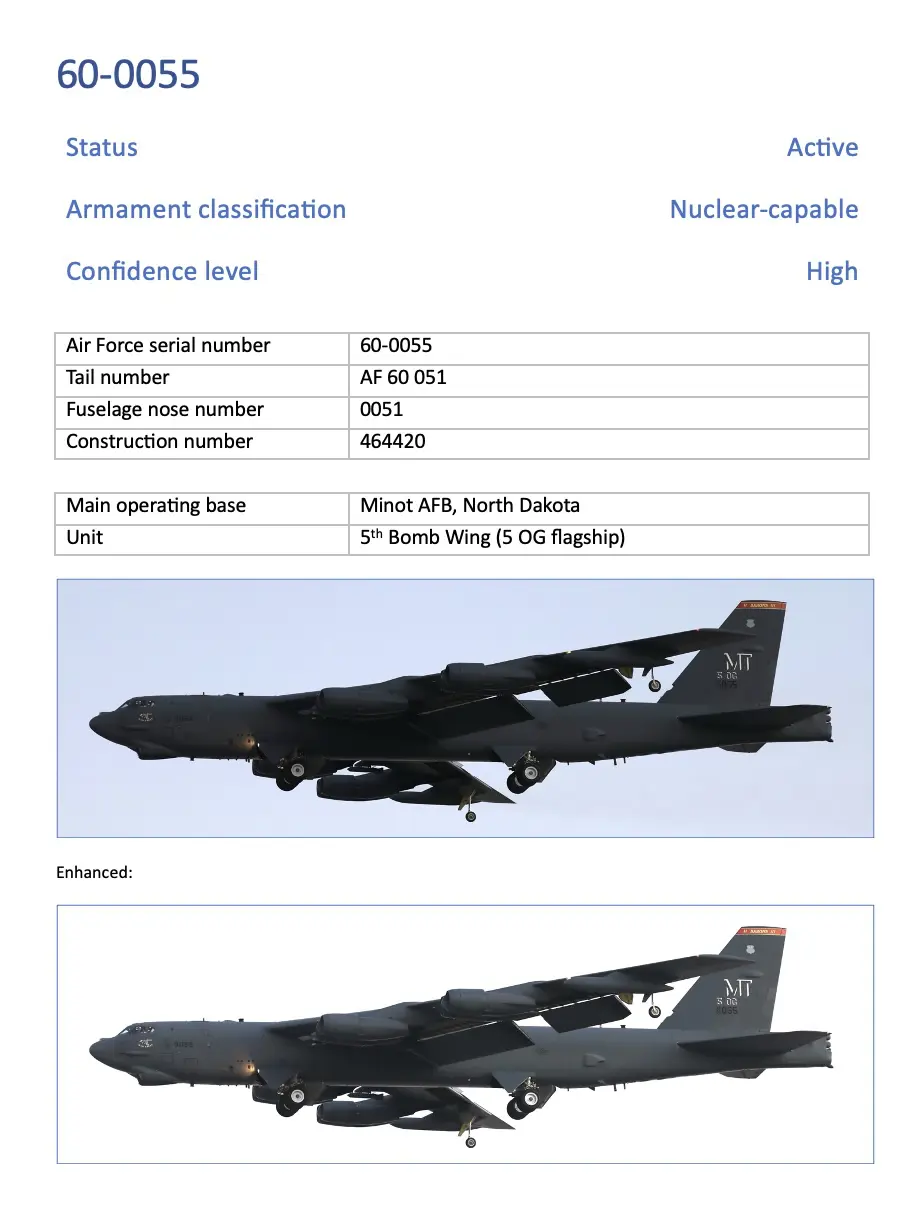 Each aircraft entry includes a citation of a primary source and a secondary source which provide the foundation for the aircraft’s armament classification, with full publication details and internet link to the original imagery (Figure 1 in full report at p. 19, here). For active fleet aircraft, a trimmed, low resolution main photograph from the primary source is followed by three cropped extracts from that main photograph showing the presence or absence of a New START fin, the tail number, and/or the nose number to confirm identification. In cases where the legibility of those images is limited by exposure problems, an additional set of enhanced images has been included, and noted as such. In a small number of cases, it has not been possible to reproduce these images for copyright reasons. These entries are marked as such, and readers are encouraged to consult the original online images if they wish to confirm the armaments classification assigned. (Figure 2 in full report at p. 24 here)
Each aircraft entry includes a citation of a primary source and a secondary source which provide the foundation for the aircraft’s armament classification, with full publication details and internet link to the original imagery (Figure 1 in full report at p. 19, here). For active fleet aircraft, a trimmed, low resolution main photograph from the primary source is followed by three cropped extracts from that main photograph showing the presence or absence of a New START fin, the tail number, and/or the nose number to confirm identification. In cases where the legibility of those images is limited by exposure problems, an additional set of enhanced images has been included, and noted as such. In a small number of cases, it has not been possible to reproduce these images for copyright reasons. These entries are marked as such, and readers are encouraged to consult the original online images if they wish to confirm the armaments classification assigned. (Figure 2 in full report at p. 24 here)
Since in this Special Report the armament classification protocol has strictly been applied only to those aircraft in the active fleet, images for aircraft in storage, or those in ground maintenance or similar inactive roles, are provided only for improved understanding. There are no claims made in this report concerning the confidence level of the conversion status of aircraft in storage, except in the case of two aircraft that have been returned to service after a period in long-term storage – one converted to conventional-only, and the other returned as nuclear-capable, having never been converted. US declarations of the conventional-only status of all B-52H aircraft in storage have been taken at face value.
Part 4. Technical appendices
Part 4 consists of five appendices dealing largely with technical and historical matters, including tracking of often confusing reports of additions and deletions to different categories of the USAF B-52H inventory, armament capability changes to bring the US into conformity with its obligations under the New START treaty, and a more extended discussion of US neither-confirm-nor-deny policy and its history.
Appendix 1 outlines the command structure for the B-52H active fleet. All frontline B-52H bombers in the USAF are assigned to two major commands that report directly to USAF Headquarters, while a handful of training and testing aircraft are assigned to two other major commands. Major commands are generally organized into one or more numbered air force, wing, group, and squadron. (Box 1. USAF command structure – organization.)
Appendix 2 traces the often confusing changes in status to the total 102 B-52H aircraft that were originally built in 1960 and 1961, including a detailed account of changes in the active, inactive, storage and destroyed status from 2014 to 2024. (Table 9. B-52H fleet structure, 2014-2024.)
Appendix 3 provides a detailed history of the B-52H armament capability changes over the past decade. (Table 10. B-52H New START Treaty-related armament capability changes, 2014-2024.) Between September 2015 and March 2017, a total of 41 B-52H bombers were converted to conventional-only status.
Appendix 4 provides a listing of all ten B-52H aircraft that have been destroyed in aviation incidents since the first such case in 1967 and are obviously therefore not subject to accountability under the New START treaty. (Table 11. B-52H aircraft destroyed in aviation incidents.)
Appendix 5 amplifies several aspects of the discussion of US policy to neither confirm nor deny the presence of nuclear weapons as discussed in the main body of this paper. It includes a schematic exploration of three potential dimensions to any given application of the policy in relation to countries hosting nuclear-capable delivery platforms.
The full version of the Special Report is available here (11.3MB PDF) and at the B-52 Stratofortress Bombers Project here
III. ENDNOTES
[1] Between 1952 and 1962, the Boeing Company built 744 B-52 bombers and eight different models, designated A through H, including 102 B-52H models. After 1994, the B-52H was the only model remaining in service. B-52Hs will reportedly be redesignated B-52Js after receiving a scheduled Rolls Royce engine upgrade. John A. Tirpak, ‘It’s Official: The Re-Engined B-52 Will be the B-52J’, Air and Space Forces Magazine, 5 April 2023, at https://www.airandspaceforces.com/re-engined-b-52-b-52j/.
[2] Hans M. Kristensen and Matt Korda, ‘United States nuclear weapons, 2023’, Bulletin of the Atomic Scientists, Volume 79, No. 1, Table 1, p. 29, at https://www.tandfonline.com/doi/full/10.1080/00963402.2022.2156686. A further 200 B61 nuclear warheads classified as ‘non-strategic’ are available for delivery by F-15E, F-16D and F-35A strike aircraft belonging to the US Air Force and the air forces of five European allied countries.
[3] All B-2 Spirit bombers are dual-capable – meaning all are able to deliver both nuclear weapons and non-nuclear weapons.
[4] US policy is to maintain 46 nuclear-capable and 30 conventional-only B-52s. However, due to aviation incidents, there were 29 conventional-only B-52 aircraft in the active fleet from 2017 to 2020. Since March 2021, the active fleet has operated at a full strength of 46 nuclear-capable and 30 conventional-only B-52 aircraft (Table 10).
[5] 13 B-52H bombers were originally retired into long-term storage over 2008 and 2009, and two have since returned to active service after a lengthy restoration process to replace aircraft in the active fleet that were damaged or destroyed in aviation incidents. Appendices 2, 3, and 4 provide technical information on historical developments in the makeup and armaments of the B-52H fleet from 2007-2024.
[6] Bryant Harris and Stephen Losey, ‘Congress wants to restore nukes on conventional B-52 bombers’, Defense News, 19 June 2024, at https://www.defensenews.com/air/2024/06/18/congress-wants-to-restore-nukes-on-conventional-b-52-bombers/.
IV. NAUTILUS INVITES YOUR RESPONSE
The Nautilus Asia Peace and Security Network invites your responses to this report. Please send responses to: nautilus@nautilus.org. Responses will be considered for redistribution to the network only if they include the author’s name, affiliation, and explicit consent


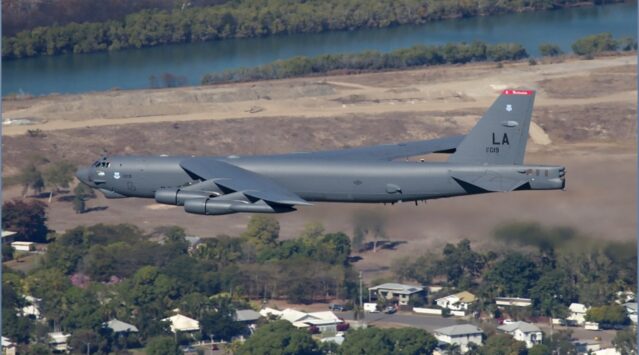
This work is of vital significance to the public and alerts us to the possibility of nuclear weapons being launched from Australian territory in a US war for example against China. Thank you and to the authors for their exhaustive work on this subject. I would like to know whether the ” fins” which identify a B52 capable of carrying nuclear weapons is essential from a functional point of view for the carrying of nuclear weapons or is merely an identification mechanism. If the latter, could it be removed to disguise the payload in a war situation?
Hello richard and Vince – you are very thorough! thanks for this excellent piece, confirming what many of us have thought for years. The upgrade at Tindal and the huge fuel tanks in Darwin certainly point to nuclear armed B52s visiting frequently. Years back, retired Navy Admiral Gene La roque told me that if any U.S. military platform is capable of carrying nuclear weapons, it will be nuclear armed, prodding his finger on the table to empahasise the point.
And re. submarines….as President Biden et. al. were in San diego launching AUKUS, Biden claimed that the virginia class coming to grace us with their presence would not be nuclear armed…..but they are CAPABLE of carrying nukes, and with a recent Congressional report indicating that it would be preferable to cut out stages two and three of Pillar 1 (i.e. “lending” us virginias, then selling us second hand ones, then just maybe helping to deliver the AUKUS specials) meaning that the U.S. Navy would control all operations and deployment (which they would anyway, despite claims by Marles that an Australian flag atop a sub. would maintain our sovereingty – Ha!), then with their neither confirm nor deny policy, those Virginias could easily be fitted with nukes and the Australian govt. wouldn’t even “know”.
Right now, Albanese is at Stirling, where a virginia has ported for a full maintenance visit – I feel sick!
But thanks to both of you for your diligence and fortitude. We’ve got to keep pointing out the grave problems with this dreadful agreement. I long for cancellation of the force Posture agreement and the sinking of the subs deal to be an election issue. Dream on!
Towards peace and inter-generational climate justice,
Jo Vall
Great work. I’m also interested in Bevan’s question about the New START fun.